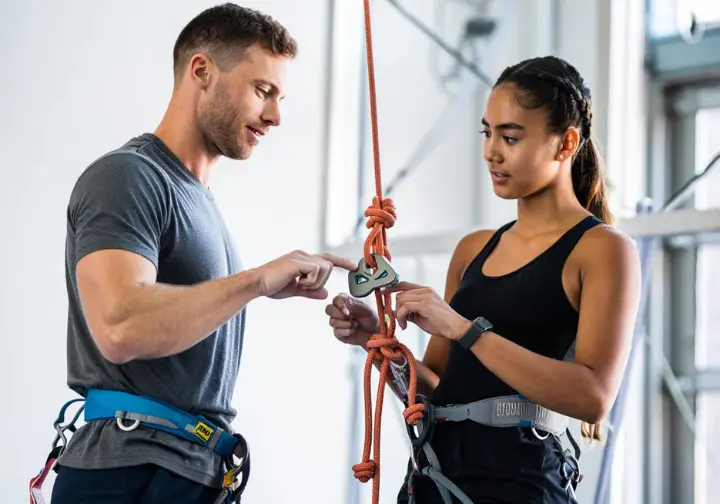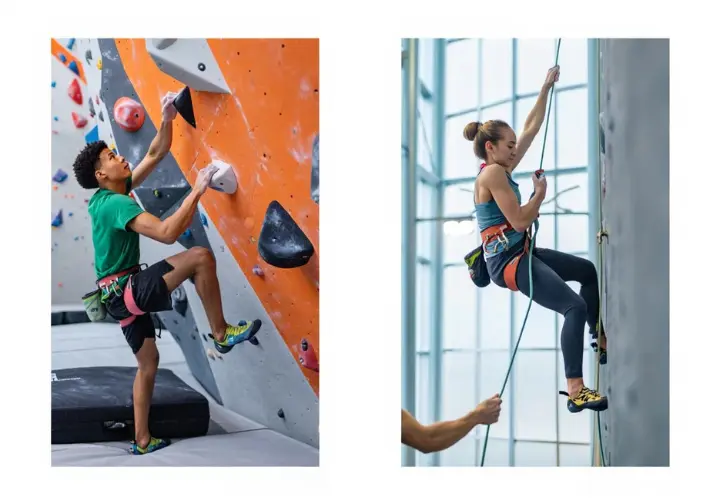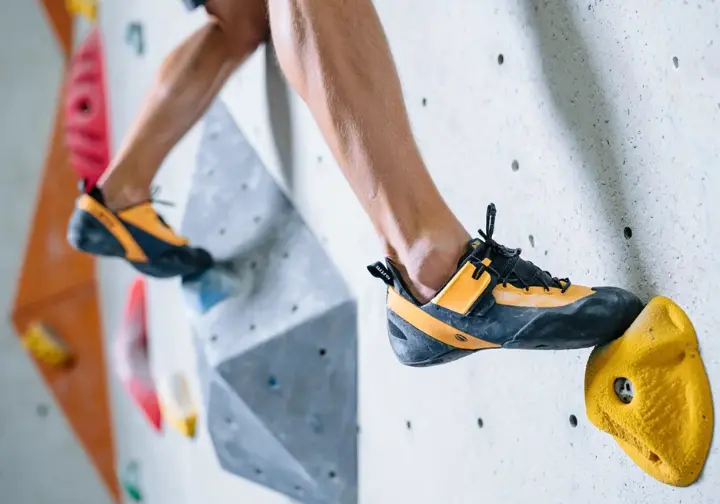In this article
Welcome to the exhilarating world of rock climbing! This guide will illuminate the essential first steps to learn how to rock climb safely, paving a clear path to your first successful ascent. We’ll delve into the unique blend of physical challenge and mental puzzle that makes climbing so rewarding and accessible for any aspiring rock climber. Prioritizing safety through proper guidance is the cornerstone of a sustainable climbing passion. We will cover choosing your environment, understanding basic climbing technique, and essential climbing gear, empowering you to experience the joy of the climb. Many rock climbers start their adventur this way.
Safety First: Understanding and Mitigating Risks

Embarking on your climbing adventure means putting safety at the forefront. This section covers the vital safety knowledge every novice climber needs. We’ll explore understanding inherent risks, the importance of professional guidance, and fundamental safety protocols, particularly within a rock climbing gym. Our aim is to equip you with the awareness needed to ensure your initial climbs are both secure and positive, helping you learn how to rock climb safely. Understanding the potential for a rock fall or other hazards is part of this.
Recognizing and Respecting Climbing Risks
Rock climbing, while thrilling, involves inherent risks; a “safety first” mindset is paramount from your initial encounter with the rock. Understanding that perceived risks are manageable with proper training is key. This awareness aids in informed decisions and respecting your climbing area, whether it’s an indoor rock wall or real rock outdoors. Many resources offer a beginners guide to rock climbing which can further detail these initial considerations for beginner rock climbers.
Common risks for beginner rock climbers, especially in outdoor rock environments, include falls, muscle strains, or abrasions. However, established climbing gyms are designed to minimize these with safety systems, padded flooring, and oversight. Learning in such a controlled setting drastically reduces potential dangers when you rock climb. For context on incident rates, some studies provide indoor climbing injury stats that show a relatively low injury rate in supervised settings. Even advanced rock climbers started with these basics.
Risk assessment isn’t just for experts; beginner climbers should be aware, listen to instructors, and not exceed their current training or attempt difficult climbing prematurely. This respect for safety makes climbing relatively safe, especially indoors. Adhering to fundamental rules and safety protocols is a non-negotiable part of the sport for all climbers.
Differentiating perceived risk (how dangerous something feels) from actual risk (the statistical likelihood of an incident where a rock climber slips) is important. Professional instruction helps bridge this gap, teaching trust in reliable safety systems and techniques.
The Crucial Role of Professional Instruction
Professional instruction is the most effective path to learn rock climbing safely, building a strong foundation in climbing technique and safety procedures. Certified instructors, often found through local climbing organizations or American Mountain Guides associated programs, offer personalized feedback, correct errors early, and explain the “why” behind safety rules. Their expertise is invaluable for navigating the initial learning curve. A structured Beginner Climbing Syllabus or introductory courses often outline what you can expect to learn from such lessons.
Qualified instructors teach climbing skills like belaying, knot tying, movement, and risk management in a structured way. They foster a supportive environment where questions and confidence building strength and skills can occur. This guidance surpasses learning from inexperienced friends or online videos alone. Many organizations offer comprehensive rock climbing courses designed for various skill levels, from beginner rock climbing to more technical rock climbing.
Look for rock climbing gyms with beginner rock climbing courses taught by professionals, like a certified Climbing Wall Instructor. These cover fundamentals for a safe introduction. Don’t hesitate to ask about instructor qualifications. What questions might you ask a potential trainer or professional climbing guides?
Beyond technical climbing skills, instructors offer insights into managing fear, problem-solving, and climbing etiquette. This holistic approach helps new climbers integrate into the climbing community and fosters a long-term passion for the sport, whether it’s bouldering, sport-climbing, or even future mountain climbing.
Essential Gym Safety: Belaying and Partner Checks
Belaying is a critical safety technique in top-roping and lead climbing, and understanding its basics is vital for any climber. It involves using a belay device, a key piece of belay equipment, to manage the climbing rope and catch a climber in case of a fall. Knowing a competent belayer manages your rope builds immense trust. For more information, you can explore resources detailing Belaying is a critical safety technique.
Partner checks, or “buddy checks,” are a non-negotiable safety step before any roped climb. Both the climber and belayer (your partner climber) meticulously check each other’s climbing harness, knots (e.g., Figure-eight follow-through), and belay device setup. This redundancy significantly reduces risks from climbing equipment misuse. Adherence to established protocols, like those outlined by the UIAA Safety Standards, is a hallmark of safe climbing practices.
Clear, standardized communication using established climbing commands (e.g., “On belay?”, “Climbing!”) is vital for coordination. Instructors teach these commands, and consistent use prevents misunderstandings. Many gyms provide excellent Safety Tips for Indoor Climbing that reinforce these communication protocols.
While you might not learn to belay on day one, observing your instructor enhances your appreciation for the safety systems in place for roped climbing. Many gyms offer introductory belay classes, often called a typical top-rope cours, as a next step.
Safe Falling in Bouldering
Bouldering involves climbing without a rope on shorter walls, using thick crash pads on the ground to cushion falls. Learning how to fall correctly is a critical bouldering safety skill to minimize impact injuries. Instructors demonstrate and have you practice controlled falls. This is one of the first basic climbing techniques you’ll encounter in bouldering when tackling a boulder problem.
The basic technique involves landing on your feet first, bending knees to absorb the impact, then rolling onto your side or back to distribute the force. Avoid trying to catch yourself with outstretched arms. The goal is to dissipate energy smoothly. Understanding proper falling technique is emphasized in most introductory bouldering classes for boulderers.
Situational awareness is also key when bouldering and falling. Before starting a boulder problem, ensure the landing zone is clear of obstacles (water bottles, other climbers) and that crash pads are positioned correctly. Be aware of other climbers who might be falling near you. Considering protective measures in bouldering like these is part of the sport’s inherent safety culture.
Crash pads offer significant protection but don’t eliminate all risk from falling off boulders. Climb within your ability, especially when new to bouldering, and consider learning proper falling techniques as part of your initial skill development. Don’t hesitate to downclimb or ask for a “spot.”
Getting Started: Your First Steps into Climbing

This section offers a practical guide to your initial logistics. From choosing the right place to learn rock climbing, to knowing what to wear and expect before you even touch the climbing wall, we’ll help you prepare for a smooth first experience.
Choosing Your Learning Environment: Gyms vs. Outdoors
For your first climb, an indoor climbing gym is overwhelmingly recommended by experts as the safest, most controlled environment. Rock climbing gyms offer purpose-built walls, professionally set climbing routes for all skill levels, readily available rental climbing gear, and qualified instructors. This minimizes variables, letting you focus on learning the basics. Choosing the right gym is an important first decision when you want to find a climbing gym.
Outdoor rock climbing introduces complexities like variable rock quality, weather conditions, and the need for more extensive climbing equipment and safety knowledge (e.g., anchor building for technical climbs). While appealing, it’s generally not suitable for a true beginner rock climber‘s first-ever experience unless under the strict supervision of a certified guide in a beginner-specific outdoor course. If you’re curious about finding a suitable facility, there are resources on how to find climbing gym options near you.
When selecting a climbing gym, consider factors like its reputation for safety, the quality and availability of beginner rock climbing classes, the friendliness of staff, and overall atmosphere. Many gyms offer introductory packages or day passes so you can try them out. Some gyms even offer specialized Indoor Rock Climbing private lessons for focused learning.
Some gyms specialize more in bouldering (perhaps a local bouldering wall), while others have extensive top-roping and lead climbing areas. Think about what type of climbing—whether bouldering or rope climbing—interests you most initially, though most beginner climbers will start with bouldering or top-rope climbing.
What to Expect from an Introductory Class
An intro to rock climbing class is excellent for starting your climbing journey, typically lasting a couple of hours and covering essentials. Expect to learn about gym safety rules, basic climbing terminology, how to put on a climbing harness correctly, and fundamental movement techniques. The goal is a safe, positive first taste of climbing. Many resources, like REI’s guide on Getting Started Rock Climbing, outline what these initial sessions entail.
Instructors guide warm-ups, then introduce bouldering or top-roping on beginner-friendly routes. They teach using holds, body positioning, and effective footwork. Ask questions throughout! Some gyms even offer Beginners Night specials to make these introductory experiences more accessible, a good challeng for new climbers.
Most introductory courses include all necessary rental climbing gear, such as climbing shoes and a climbing harness (if top-roping). The instructor ensures your climbing equipment fits correctly and show you how to use it. This is a great way to try out beginner-friendly routes without prior investment.
The class likely includes gym orientation, explaining how climbing routes are graded (marked by difficulty or grades) and general gym etiquette. The atmosphere is usually very supportive and geared towards making beginner climbers feel comfortable climbing.
Dressing for Success: What to Wear Climbing
Choose comfortable athletic clothing allowing a full range of motion for your first climb. You’ll stretch, reach, and contort your body, so restrictive clothing like jeans is not recommended. Think yoga pants, athletic shorts, or flexible track pants. Knowing what to wear for indoor rock climbing can make your first experience much more comfortable.
A breathable t-shirt or tank top is good for your upper body. Layers help if the gym is cool, but you’ll likely warm up quickly once you start climbing. Avoid overly baggy clothing that could get caught on holds or interfere with your climbing harness. Many climbers want to know What to Expect in Your First Climbing Session, and appropriate attire is a big part of that.
You’ll rent specialized climbing shoes (also known as rock shoes) at the gym; wear or bring a pair of thin socks. Some climbers prefer to go barefoot in climbing shoes for a better feel, but socks are often recommended for hygiene with rentals. For a broader look at climbing gear, some guides list Essential Climbing Gear for Beginners, though rentals cover you initially. Your favorite climbing shoes will come later, with experience.
Remove any jewelry like rings or necklaces. Tie back long hair so it doesn’t obstruct vision.
Understanding Waivers and Gym Orientation
Before you can climb at any gym, you’ll be required to sign a waiver. This legal document outlines the inherent risks of rock climbing and confirms that you understand and accept them. Read it carefully; it’s standard for informed consent. The process of Signing Waivers is a common first step at any climbing facility.
Most climbing gyms provide a brief orientation for first-time visitors, even if you’re taking a class. This orientation will cover important gym-specific rules, safety guidelines, the layout of the facility, and how to identify different climbing areas (bouldering, top-rope, etc.). Pay close attention. Often, you’ll Start with an Induction Session that covers these critical points.
Orientation might include auto-belay instructions and basic gym etiquette like not walking under other climbers. This creates a safe, respectful environment for everyone.
This initial administrative part of your visit is important. It ensures everyone using the facility is aware of the potential risks and the rules in place to mitigate them, contributing to a safer experience for all climbers.
Decoding Your First Climb: Environments and Gear

This section introduces common beginner-friendly climbing types and the essential climbing gear you’ll encounter, focusing on rentals and their importance. We’ll demystify the climbing equipment so you can focus on the climb itself.
Bouldering vs. Top-Roping: Which is for You?
Bouldering and top-roping (a form of rope climbing) are the two most common, recommended types of climbing for beginner climbers in an indoor gym. Bouldering involves climbing shorter walls (usually 10-15 feet) without ropes, with thick crash pads below to cushion falls. It’s great for developing power, climbing technique, and problem-solving skills on various boulder problems. Many ask what type of climbing is best for beginners, and these two different climbing disciplines are prime candidates.
Top-rope climbing involves climbing taller walls with a rope that is already anchored at the top. The climber is securely tied to one end of the rope, and a belayer manages the other end through a belay device, taking up slack as the climber ascends and lowering them safely after the climb or if they fall. This often feels more secure for beginner climbers anxious about falling. For a deeper dive, consider understanding top-roping. An ultimate guide for beginners will often compare these two styles of climbing extensively.
Many beginner rock climbers try both styles during their initial sessions to see which they prefer. Bouldering requires less initial climbing gear (no climbing harness or belay device needed for the climber) and you can often do more climbs in a session, while top-roping introduces the concept of rope systems and working with a climbing partner.
Your choice might also depend on the gym’s facilities or the structure of an introductory class. Both are excellent ways to experience the fundamentals of climbing movement and build initial confidence. Some may eventually explore free climbing or even technical climbing disciplines like crack climbing or aid climbing as they progress.
Your First Encounter: Essential Rented Gear
For your first time climbing gym visit, you won’t need to buy any specialized climbing gear; climbing gyms provide all the essentials for rent. This is standard for beginner climbers, allowing you to try the sport without a significant upfront cost. The package includes climbing shoes and, if you’re top-roping, a climbing harness. This is part of the basic climbing gear introduction.
Climbing shoes have sticky rubber soles for enhanced grip on holds and a snug fit for precise footwork. Rental rock shoes are generally durable and comfortable, suiting various beginner feet. You can learn more about Essential indoor climbing gear to understand what you’ll be using. Eventually, you might invest in your own climbing gear.
A climbing harness is worn around your waist and legs, essential for top-roping, as it’s the point where you securely tie into the climbing rope. Staff or your instructor will show correct usage and fit.
Chalk (magnesium carbonate) is used to absorb sweat from your hands and improve grip. While some gyms include a chalk bag with chalk in their rental package, others may offer it as a separate small rental or for purchase.
Understanding Climbing Shoes and Harness Fit
Proper fit for climbing shoes is important for performance and comfort, though for your first time, comfort is often prioritized. Rental climbing shoes should fit snugly, like a firm handshake for your feet, with your toes just touching the end, but not painfully crunched. No major gaps or slipping, especially in the heel. The Importance of proper fit climbing shoes cannot be overstated, even for rentals.
When trying rental rock shoes, ensure your foot doesn’t move inside the shoe when you try to stand on your toes or edge on a small feature. Avoid shoes that cause sharp pain. Communicate with gym staff; they can help. Finding the right climbing shoe fit is a journey, and it starts with understanding these basics.
A climbing harness must also fit correctly to be safe. The waistbelt should sit above your hip bones and be tightened so that you cannot pull it down over your hips. The leg loops should be snug but not constricting, allowing for movement. Getting a good beginner rock climbing harness fit is equally important.
Your instructor or gym staff will help adjust your climbing harness. Ensure all buckles are correctly threaded and no twists in webbing. A Correct fit harness distributes fall forces properly.
The Basics of Auto-Belay Systems
Many climbing gyms are equipped with auto-belay devices, which allow you to climb taller roped walls without needing a human belay partner. An auto-belay is a mechanical device that automatically takes in slack as you climb and controls your descent when you let go or fall. They are a convenient way to get a lot of climbing in, especially for indoor top-rope climbing. An Auto-Belay Systems explanation is usually part of a gym’s introductory safety briefing.
Before using an auto-belay, receive specific instruction from gym staff on how to use it correctly and safely. This includes how to properly clip the carabiner into your climbing harness belay loop, ensuring it’s locked, and understanding the descent process. Always perform checks. This is often covered during the gym orientation and safety briefing.
When climbing on an auto-belay, it’s crucial to climb directly up the route associated with that device and avoid traversing too far to the sides, which can cause a pendulum swing if you fall. Always be aware of the designated climbing path for the auto-belay you are using.
Descending on an auto-belay is usually a smooth, controlled experience. Simply let go of the wall (or push off gently), and the device will lower you to the ground at a consistent speed. Remember to look below you as you descend to ensure your landing area is clear.
Mastering the Moves: Fundamental Climbing Techniques

Discover foundational movements that will make your first climb more efficient and enjoyable. This section focuses on intelligent body use, from footwork to positioning, helping conserve energy and climb smarter. These are the basic climbing techniques that form the core of your new climbing skills. Perfecting climbing technique is a long-term goal for every rock climber.
Using Your Feet: The Foundation of Good Technique
A common beginner tip for rock climbers is “use your feet“; your legs are stronger than your arms. Focus on pushing yourself up the wall with your legs, not pulling with your arms. Think of climbing a ladder – you step up, using your arms primarily for balance. Indeed, Feet are the foundation of climbing.
Precise footwork means carefully placing your feet on holds, using the inside edge or the toe of your climbing shoe for better contact. Avoid slapping your foot; look, aim, and place deliberately. This builds good habits. Understanding basic edging and smearing concepts will come with practice and instruction, vital for navigating different types of rock and holds, including small cracks.
Keep weight over your feet as much as possible for balance and reduced arm strain. Good footwork allows standing on holds, conserving arm strength. This is key to using legs effectively and is a core part of climbing technique.
Instructors often emphasize “quiet feet” – placing your feet gently and accurately without readjusting. This improves efficiency and foot trust.
Body Positioning for Efficiency and Balance
Efficient body positioning is key to making climbing feel easier and less strenuous. Try to keep arms as straight as possible when hanging or resting. Bent arms fatigue muscles quickly; straight arms use your skeleton for support. The adage “Straight arms are happy arms” is very true in climbing. This helps conserve strength.
Keeping your hips close to the wall is another vital climbing technique. This centers weight over your feet, improves balance, and aids reaching. Beginner climbers often climb with their hips too far out, straining arms. Actively thinking about maintaining hips close to the wall is a game-changer for any climber.
Focus on smooth, controlled movements rather than jerky, panicked lunges as the climber moves. Think about your center of gravity and how you can shift it to maintain balance. This is part of refining climbing techniques like footwork and body positioning and is essential for tackling more challenging climbs.
Look for rest opportunities, even brief ones. Shaking out one arm while the other maintains a good hold, or finding a stable position where you can take weight off your hands, can make a big difference in managing fatigue during longer climbs.
Introduction to Basic Handholds and Grips
Climbing walls feature varied handholds, each needing a slightly different grip. For beginner climbers, the most friendly holds are often called “jugs” – large, positive holds you can get your whole hand around – are most friendly. These build confidence. Recognizing and using ‘jugs’ is an early skill for every rock climber.
You’ll encounter crimps (small edges), slopers (rounded, friction-based), and pinches (squeezed between thumb/fingers). Your instructor will likely point these out. Learning how to use holds effectively is a continuous process, and understanding essential hold types like jugs is the first step. These holds are found on both indoor rock walls and outdoor rock.
A common mistake for beginner climbers is to overgrip holds, squeezing harder than necessary. This wastes energy and tires forearms quickly. Try to use a relaxed grip, applying just enough pressure. Strength development for grip will come with time and training, including specific hang training.
Chalk helps grip by absorbing sweat, but good climbing technique is more than chalk or brute strength. Learning to use different types of holds effectively is a key part of climbing progression.
Reading Beginner Routes and Basic Movement
In gyms, climbing routes (or “boulder problems” in bouldering) are marked with colored tape or holds of the same color. The start of a route is often indicated with marked starting handholds. The goal is to climb from these starting holds to the designated finishing hold, using only holds of the specified color. This concept of following holds of a specific color or set is fundamental to climbing grades and progression.
“Reading a route” means looking at the hold sequence before you start climbing and planning your moves. For beginner climbers, this might be identifying the next one or two holds. Experience helps anticipate body positions further up. This is central to understanding a boulder problem and applies to all climbing routes.
Basic climbing movement often involves moving one limb at a time while maintaining three points of contact with the wall for stability. Focus on controlled, deliberate movements. This is a core climbing technique.
Don’t be afraid to ask for “beta” (advice) from instructors or experienced climbers if stuck. Climbing is problem-solving; sharing solutions is part of the community spirit. This is true for simple climbs and complex technical ascents.
Beyond the Wall: What to Expect and Next Steps

Learn about physical and mental aspects of your first climb, common climbing terms, and gym etiquette. This section also guides what to do after your initial session to continue your climbing journey.
Physical and Mental Sensations: What’s Normal?
Feeling muscle soreness after your first climbing session is normal, especially in forearms, fingers, and back, even if fit. Climbing uses muscles uniquely. Gentle stretching and hydration help. Anticipating muscle soreness is part of the first-time experience for any rock climber.
You might also feel fatigue. Climbing is a full-body workout requiring mental focus. Don’t be surprised if you feel tired but accomplished. While there isn’t a strict basic fitness level for climbing to start, you’ll certainly feel the effort. This is part of building strength.
Mentally, expect excitement, nervousness, frustration if a move is difficult, and elation when you complete a climb or boulder problem. Managing fear, especially the fear of falling, is a common aspect of climbing, even in a safe gym environment. Trusting your climbing gear and your belayer (or the crash pads) is key. Sometimes, taking a moment can provide mental clarity to reassess strategies.
Many beginner climbers are surprised by the problem-solving aspect of climbing. Climbing routes are often like vertical puzzles. This mental engagement is one of the reasons many people find climbing so addictive, from their early climbing days onwards.
Essential Climbing Lingo for Beginners
Climbing has its jargon; knowing basic terms helps understand instructors and other climbers. A “route” or “problem” refers to the path you climb. “Holds” are what you grab onto with your hands and step on with your feet. There are many glossaries available, some even covering Olympic Sport Climbing terms, which can be very comprehensive. The history of rock climbing is also rich with unique terminology.
“Belay” refers to securing a roped climber. The “belayer” manages the rope. Common climbing commands include “On belay?” (climber asking if belayer is ready), “Belay on!” (belayer confirms readiness), “Climbing!” (climber starting), and “Take!” (climber asking belayer to take their weight on the rope). Understanding climbing terminology will make instructions much clearer.
“Beta” is advice on climbing a specific route. “Crux” is the hardest move(s) on a route. A “jug” is a large, easy-to-grip handhold. “Flash” means completing a route on the first try after getting beta.
Don’t worry about learning all the terms at once. You’ll pick them up naturally. Instructors explain key terms as they arise.
Climbing Gym Etiquette: Being a Good Citizen
Climbing gyms are shared spaces; good etiquette ensures everyone has a safe and enjoyable experience. Be aware of your surroundings, especially in bouldering areas where people might be falling. Don’t walk or sit directly underneath someone who is climbing. Following Good Climbing Gym Etiquette is crucial for a positive community environment.
Take turns on climbing routes, especially popular ones. If others wait, don’t monopolize a route. Be mindful of personal space. The Benefits of Engaging with the Climbing Community are numerous, and good etiquette is foundational.
Keep noise reasonable. Encouragement is welcome; excessive shouting isn’t. Keep your climbing gear organized and out of walkways. Adhering to etiquette and safety guidelines is part of being a responsible climber.
Listen to gym staff and follow any specific rules posted. If unsure, ask. Respecting others and the facility maintains a positive climbing community.
Your Climbing Journey: What Comes Next?
After your first taste of climbing, what’s next? If you enjoyed it, consider more classes, like belay certification for top rope climbing with partners, or a climbing technique-focused class. A Beginners Guide to Training for Climbing can offer structured ways to improve your climbing skills.
Many gyms offer memberships or punch passes for regular climbing. Joining a gym gives access to the climbing community, potential partners, and experienced climbers. The Journey of Rock Climbing Progression is a personal one, but shared experiences help. Perhaps you’ll find your personal climbing hero there.
Set simple goals: a certain grade of route, mastering a particular climbing technique, or simply climbing consistently. Goals provide motivation and progression. How will you track your progress on different climbs or boulder problems?
Climbing is skill-based; progress comes with practice and patience. Don’t get discouraged if some things feel difficult at first. Focus on enjoying the process of learning and challenging yourself, which is key to enhancing rock climbing skills and safety as you move towards intermediate climbing or even advanced climbs.
Conclusion: Your Adventure Awaits
Starting rock climbing is an exciting endeavor, offering immense physical and mental rewards. By prioritizing safety, seeking professional instruction, and understanding fundamentals from your first climb, you set yourself up for a fulfilling passion. Always begin in a controlled environment like a climbing gym, learn basic safety like partner checks and proper falling, and focus on good climbing technique, especially using your feet. The world of climbing—whether bouldering on a boulder, top-roping up a wall, or eventually tackling a cliff or technical rock outdoors—awaits.
Your actionable next step? Find a reputable local climbing gym, ask about their introductory courses, and schedule your first session. Wear comfortable clothing, go with an open mind, ready to learn and have fun. This guide has equipped you with foundational knowledge to learn how to rock climb. We encourage you to continue exploring our resources for climbing gear, climbing technique, training, and amazing climbing destinations as you progress. The climbing community, from beginner climbers to professional climbers, is welcoming; embrace the chance to learn, grow, and connect.
Frequently Asked Questions about Learning to Rock Climb
Is rock climbing hard for beginner climbers? >
What is the most important safety rule in rock climbing? >
How much does it cost to start rock climbing? >
Do I need to be really strong to start rock climbing? >
We are a participant in the Amazon Services LLC Associates Program, an affiliate advertising program designed to provide a means for sites to earn advertising fees by advertising and linking to Amazon.com. As an Amazon Associate I earn from qualifying purchases. We also participate in other affiliate programs. The information provided on this website is provided for entertainment purposes only. We make no representations or warranties of any kind, expressed or implied, about the completeness, accuracy, adequacy, legality, usefulness, reliability, suitability, or availability of the information, or about anything else. Any reliance you place on the information is therefore strictly at your own risk. Additional terms are found in the terms of service.











